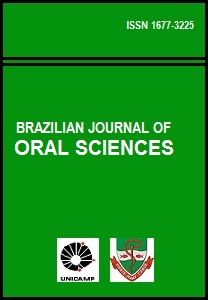Abstract
The Triangle Hyoid was measured by cephalometric measures in Brazilian individuals from Piracicaba’s region by establishing comparisons with the values existing in the literature objectiving to establish values of normality for the position of the hyoid bone. The sample consisted of 31 cephalometric radiographs of Brazilian individuals with Angle’s Class I malocclusion, mix dentition,16 boys and 15 girls with ages raging from 8 to 15 years. The gotten data had submitted it test “t” of Student that showed the occurrence of sexual dimorfism for the ântero-posterior position of the hyoid bone(H) to the retrognation (RGn). The antero-posterior hyoid position (H) in relation to the third cervical vertebra (C3) was constant, with values of 34.03 mm and standard deviation of 3.85. The distances between antero-posterior position of C3 and symphysis (RGn) were similar to those found in the literature. The vertical position of the hyoid bone was higher and less inclined. The correlation coefficient between the atlas vertebrae to posterior nasal espine (AA-PNS) and C3-H was significant (0.56), which is suggesting that the hyoid bone represents the previous limit of the upper airspace in a level more inferior than the PNS in accordance with the literature. It concluded itself that there is a related sexual differences and face standard with the position of the hyoid bone indicates the necessity of a refined evaluation of this bone, therefore represents an important element for the orthodontic and functional orthopedic and speech therapist and physitherapist.References
Coelho-Ferraz MJP. Avaliação cefalométrica da posição do osso hióide em respiradores predominantemente bucais [dissertação]. Piracicaba: UNICAMP/FOP; 2004.
Coelho-Ferraz MJP. Respirador bucal – uma visão multidisciplinar. São Paulo: Lovise; 2005.
Meredith HV. Growth in head width during the first twelve years of life. Pediatrics. 1953; 12: 411-29.
Kuroda T, Nunota E, Hanada K, Ito G, Shibasaki Y. A roentgenocephalometric study on the position of the hyoid bone. Bull Tokyo Med Dent Univ. 1966; 13: 227-43.
Bibby RE, Preston CB. The Hyoid triangle. Am J Orthod. 1981; 80: 92-7.
Brodie AG. Anatomy and physiology of head and neck musculature. Am J Orthod. 1950; 36: 831-44.
Durzo CA, Brodie AG. Growth of the hyoid bone. Angle Orthod. 1962; 32: 193-204.
King EW. A roentgenographic study of pharyngeal growth. Angle Orthod. 1952; 22: 23-37.
Grant LE. A radiographic study of hyoid bone position in Angle’s Class I, II, and III malocclusions [Master’s thesis]. University of Kansas City; 1959. Apud Stepovich ML. A cephalometric positional study of the hyoid bone. Am J Orthod. 1965; 51: 882-90.
Bench RW. Growth of the cervical vertebrae as related to tongue, face, and denture behavior. Am J Orthod. 1963; 49: 183-214.
Stepovich ML. A cephalometric positional study of the hyoid bone. Am J Orthod. 1965; 51: 882-90.
Ingerval B, Carlsson GE, Helkimo M. Change in location of hyoimandibular positions. Acta Odontol Scand. 1970; 28: 337-61 13. Tallgren A, Solow B. Long-term changes in hyoid bone position and craniocervical posture in complete denture wearers. Acta Odontol Scand. 1984; 42: 257-67.
Adamidis IP, Spyropoulos MN. Hyoid bone position and orientation in Class I and Class III malocclusions. Am J Orhdod Dentofacial Orthop. 1992; 101: 308-12.
Haralabakis NB, Toutountzakis NM, Yiagtzis SC. The Hyoid bone position in adult individuals with open bite and normal occlusion. Eur J Orthod. 1993; 15: 265-71.
Kollias I, Krogstad O. Adult craniocervical and pharyngeal changes - a longitudinal cephalometric study between 22 and 42 years of age. Part I: morphological craniocervical and hyoid bone changes. Eur J Orhod. 1999; 21: 333-44.
Sicher H, Dubrul EL. Anatomia oral. 8.ed. Porto Alegre: Artes Médicas; 1991.
Dahlberg G. Statistical melhods for medical and biological students. New York; 1940. Apud Houston WJ. The analysis of errors in orthodontic measurements. Am J Orthod. 1983; 83: 382-90.
Houston WJ. The analysis of errors in orthodontic measurements. Am J Orthod. 1983; 83: 382-90.
Pearson FG. Topography and morphology of the human hyoid. J Anat Physiol. 1909; 43: 279-90. Apud Stepovich ML. A cephalometric positional study of the hyoid bone. Am J Orthod. 1965; 51: 882-900.
Enlow DH, Hans MG. Noções básicas sobre crescimento facial. São Paulo: Santos; 1998.
Bibby RE. The hyoid bone position in mouth breathers and tongue- thrusters. Am J Orthod. 1984; 85: 431-3.
Simões WA, Brandão MRC. A língua e o complexo hióideo como recurso no diagnóstico e tratamento das má-oclusões. Ortodontia. 1993; 26: 89-8.
The Brazilian Journal of Oral Sciences uses the Creative Commons license (CC), thus preserving the integrity of the articles in an open access environment.

